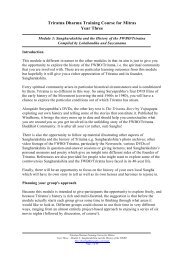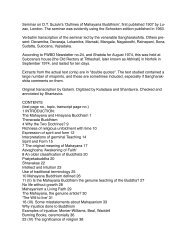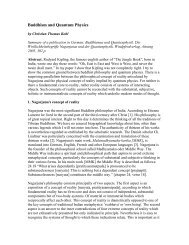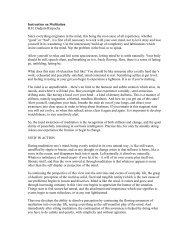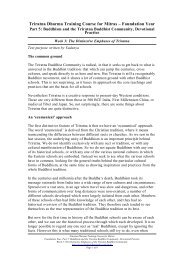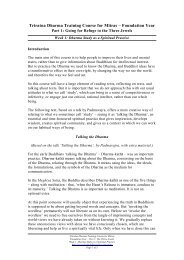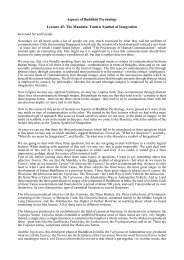Great Buddhists from Triratna Refuge Tree - Free Buddhist Audio
Great Buddhists from Triratna Refuge Tree - Free Buddhist Audio
Great Buddhists from Triratna Refuge Tree - Free Buddhist Audio
Create successful ePaper yourself
Turn your PDF publications into a flip-book with our unique Google optimized e-Paper software.
and why we can relate to this particular <strong>Refuge</strong> <strong>Tree</strong>. Maybe it will take us a while<br />
to explore the figures, but their general meaning is clear and simple.<br />
It is interesting that we have the Gurus of the Present on the front lotus i.e. Bhante<br />
and his teachers. This places Bhante in relation to the whole tradition. Obviously<br />
our teacher and our teacher‟s teachers are our doorway into the Dharma. We have<br />
not met the Buddha, so this is our immediate connection with the Buddha in terms<br />
of the esoteric refuge. However, I think it is interesting that these teachers are on<br />
the <strong>Tree</strong> now, because it does, I suppose, express a lineage. I know that Bhante has<br />
not been very keen on lineage as expressed in some other <strong>Buddhist</strong> schools in the<br />
past. A Newsletter many years ago featured an article called „What‟s Your<br />
Lineage?‟ It was an answer to people who asked about Bhante: „What‟s his<br />
lineage? Who is he?‟ as though he was some sort of upstart in the <strong>Buddhist</strong> world.<br />
Bhante has never felt a need to justify his existence in that way, but a natural<br />
interest has arisen <strong>from</strong> Order Members and people in the Movement about his<br />
teachers, particularly in relation to Dhardo Rimpoche, whom many people have<br />
met. There is a real connection, a real spiritual connection. It is not an interest in<br />
lineage <strong>from</strong> an external point of view, but a desire to know Bhante more deeply<br />
by knowing his teachers or by knowing about his teachers. Hence it seems<br />
appropriate that now we have that picture of him and his eight main teachers and<br />
we can look at that lineage. In a way, it is a picture of spiritual friendship, a<br />
picture of spiritual communication – Bhante‟s spiritual friends.<br />
The other point about that picture of Bhante and his eight teachers, that lineage, is<br />
that there are teachers <strong>from</strong> different traditions. In that way there is an expression<br />
of the breadth of the Movement, the breadth of Bhante‟s experience. There is a<br />
Theravādin teacher, a Chinese Ch‟an teacher, and Tibetan teachers <strong>from</strong> different<br />
schools or who have taken initiations <strong>from</strong> different schools. Jamyang Khyentse<br />
the <strong>Great</strong>, who is incarnated in Dilgo Khyentse and Jamyang Khyentse, founded<br />
the Rime Movement in Tibet with some of his friends. He wanted to break down<br />
the differences between the Tibetan <strong>Buddhist</strong> schools, to harmonise the lineages<br />
and to end sectarian exclusivity. He saw that the schools were caught up in<br />
regional strife and politics, and he wanted to break that down, so he and his friends<br />
went everywhere and swapped initiations so that they broke down those lineages<br />
and formed the Rime Movement, which is a very popular and powerful movement<br />
in Tibetan Buddhism today. Bhante‟s teachers are part of that movement, and<br />
<strong>Triratna</strong> reflects this approach of non-sectarianism and draws on all forms and all<br />
schools that are relevant for us today. There is teaching in the way those people<br />
practised their Dharma. They were all obviously great individuals, but they were<br />
all open-minded and prepared to practise Buddhism, just practise the Dharma, not<br />
to be caught up in sectarianism. There is a meeting of minds between Bhante and<br />
those people. I imagine his approach and their approach met. That is one of the<br />
things we can draw <strong>from</strong> Bhante and his teachers.<br />
To return to the sixteen Gurus of the Past. What we are looking at when we look at<br />
this <strong>Refuge</strong> <strong>Tree</strong> is a sort of glorious spiritual family tree. These are our spiritual<br />
relations, these are the people we can connect with. They are teachers, as I have<br />
said, <strong>from</strong> all the main countries and cultures that Buddhism has been to in the<br />
East; <strong>from</strong> India in the first place and thence to Japan, China, and Tibet. Just <strong>from</strong><br />
<strong>Triratna</strong> Dharma Training Course for Mitras<br />
Year Four, Module 7: <strong>Great</strong> <strong><strong>Buddhist</strong>s</strong> <strong>from</strong> the <strong>Refuge</strong> <strong>Tree</strong> of the <strong>Triratna</strong> <strong>Buddhist</strong> Order<br />
http://freebuddhistaudio.com/study<br />
Page 34 of 42



